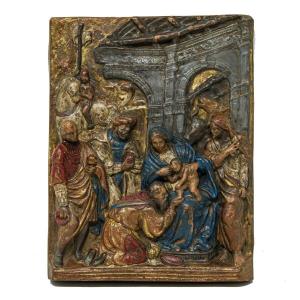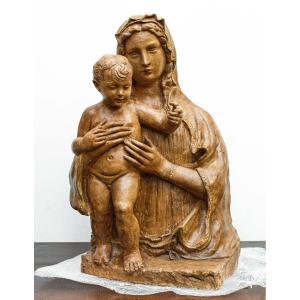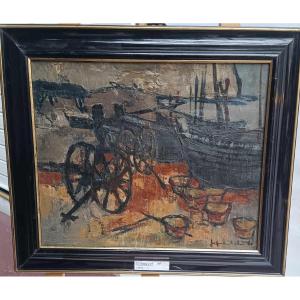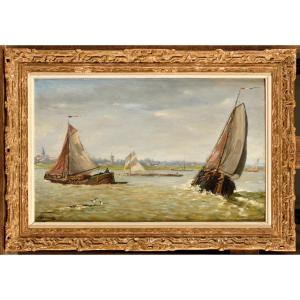View of London from the River Thames
Oil on canvas, cm 54,2 x 79,5 - With frame, cm 79,2 x 82,2
Paintings can be time machines that allow us to observe the past; and it is the memory of a London past that is represented in this painting, as can be seen from the flags hoisted on the boats. The protagonist of the scene is the Thames with its tumultuous waters crossed by boats and in the background the bank of the river where you can recognize some buildings still existing.
The area depicted is more precisely the right bank of the Thames, the one that extends from the Tower of London to the Blackfriars Bridge. This was the area most affected by the famous fire of 1666, which razed almost all buildings to the ground, almost completely destroying even the cathedral of Saint Paul. In his memory, the Monument to the Great Fire of London (The Monument) was erected between 1671 and 1677; a colossal fluted Doric column surmounted by a drum and a golden copper urn from which a series of flames emerge. Also in this painting is depicted, just behind the large building with the white facade of the Custom House. The Custom House is the historic Customs House, still used by Her Majesty’s Revenue and Customs. The history of this building began in 1813, when due to the influx of wealth and the great development of trade, larger premises were needed than those of the old headquarters at Sugar Quay (built by Thomas Ripley). In October 1813 construction began on a new building designed by David Laing: the project included a bare front towards the interior while a southern façade, which gave to the river of great grandeur.
Made following the neoclassical style, which was very successful in England in the early nineteenth century, the mighty façade is enlivened by majestic Ionic colonnades with protruding central section and attic floor above decorated with terracotta figures in bas-relief depicting the arts and sciences, trade and industry, and the inhabitants of various countries of the world. A clock face, about 3 meters in diameter, was supported by colossal figures symbolizing Industry and Abundance, and royal weapons by figures from the Ocean and Commerce. Immediately behind you can see the bell tower of the church of San Dunstan in the East, still visible among the skyscrapers of the City.
Further away you can see the London Bridge, one of the main bridges over the Thames in London that connects the City of London to the London borough of Southwark. Among its arches is another bridge; the Blackfriars Bridge (bridge of the black friars): The bridge we see today is still the one that was inaugurated by Queen Victoria in 1869 (you can still see a statue of the Queen in the north side of the bridge) and it was realized after that, between 1833 and 1840, they became necessary of the renovations of the bridge that was used until then.
The huge dome in the background is the iconic dome of St Paul’s Church, one of London’s two Anglican cathedrals, built by architect Christopher Wren between 1697 and 1711.
Immediately next to the bell tower of the church of St. Michael Paternoster Royal; the ancient building was destroyed by the Great Fire of London in 1666 and rebuilt under the aegis of Christopher Wren. What we see is a further reconstruction because St Michael’s was badly damaged by the bombing of London during World War II and is was restored between 1966 and 1968.
The object is in good condition
With Ars Antiqua you can defer all amounts up to a maximum of € 7,500 at ZERO RATE, for a total of 15 INSTALLMENTS.
Ex. Tot. € 4,500 = Monthly installment € 300 for 15 months.
Ex. Tot. € 3,600 = Monthly installment € 720 for 5 months.
For amounts over €7,500 or for a longer grace period (over 15 installments), we can provide a custom payment.
Contact us directly to get the best quote.
LIVE TV
- SUNDAY 17.00 - 21.00 Dig.terr. 126 + 809 SKY
- THURSDAY 21.00 - 24.00 Dig.terr. 134 + 809 SKY
- Streaming on our website www.arsantiquasrl.com and on our social networks Facebook and Youtube
All the works proposed by Ars Antiqua are sold accompanied by a certificate of authenticity in accordance with the law and accurate fact sheet.
You can see the works directly at the showroom gallery in Milan, in via Pisacane 55 and 57.
We personally organize transport and deliveries of the works, both for Italy and abroad.








































 Le Magazine de PROANTIC
Le Magazine de PROANTIC TRÉSORS Magazine
TRÉSORS Magazine Rivista Artiquariato
Rivista Artiquariato